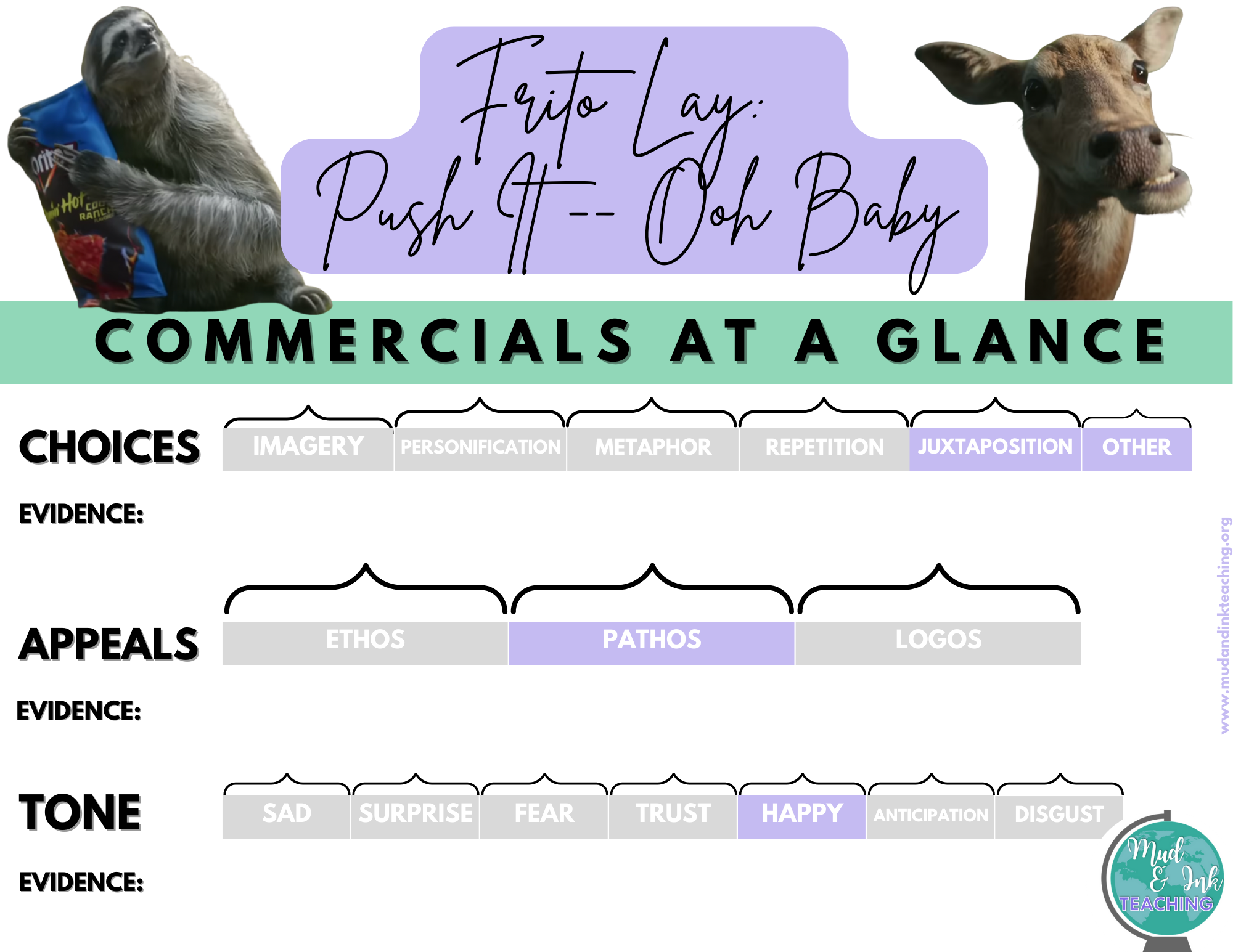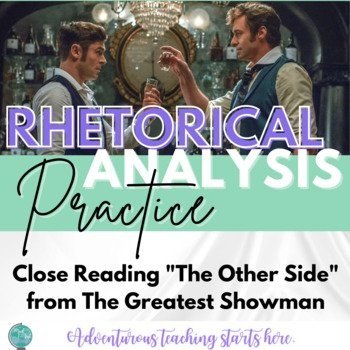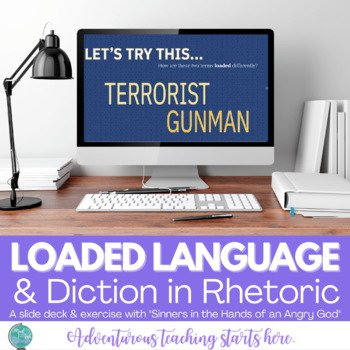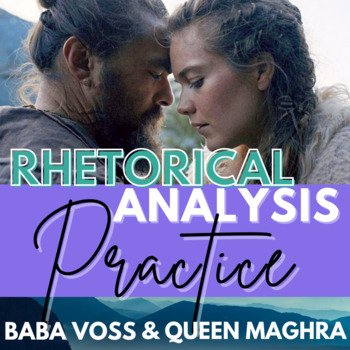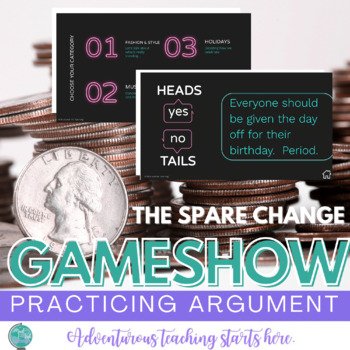3 MORE Commercials for Rhetorical Analysis
There’s just something about commercials that make them such ripe teaching tools for practicing rhetorical analysis. The problem is, though, that it can be hard to find ones that are just right for students. In an effort to continue making more commercial rhetorical analysis ideas available to teachers, I’m stepping up my game and adding a few more to the conversation right here! Let’s jump in.
A FEW REMINDERS:
Before starting with ads, make sure you’ve covered the rhetorical situation. I have an easy and fun lesson for that ready-to-go featuring the song “Be Our Guest” from Beauty and the Beast, so feel free to use it!
You might also consider having your students familiar with SPACE CAT or another framework that you like (another might be SOAPSTONE). I dive into that a bit further with the song “Mother Knows Best” from Tangled and share a free rhetorical triangle template here, too.
If you like these commercial suggestions, you might also like this blog post with three Super Bowl ads from 2022 that is very similar to this post -- just more ads to put in your arsenal!
Rhetorical analysis is a skill that needs to be practiced over and over and over again. Too often, we are introducing ethos, pathos, and logos on repeat without ever getting much further. We know rhetorical analysis is so much bigger than labeling a few appeals: it’s about understanding the power of the message in the context that it’s delivered.
START WITH YOUR TEMPLATES
If you are new to the idea of using SPACE CAT or any other framework to guide your lessons, I’ve got you covered. When I teach RA, I like to try and consistently use the same kinds of handouts for every lesson so that students aren’t constantly learning a new way to “do” the job and I’m not constantly recreating the wheel. Here’s what I’ve created for you to try with your students:
On the one side, students are brought back to the rhetorical triangle and grounded in the rhetorical situation as much as possible. Some commercials are a bit tricky to deciper (as opposed to speeches or moment from film), but make sure they start with speaker and audience at the very minimum. Then, using these templates, students can dig into the argument itself and shade in the particular choices they notice, the appeals at work, and the tone word range that they observe in the commercial. This is a very basic starting point, but it serves as a visually clear way for students to try and see all fo the pieces of the argumetn working together AND prioritizes the use of evidence for each. You might not examine all three components every time, and that’s totally okay! Simply cross out what you’re not working on and focus on the rest.
FRITO LAY: IS IT FOOTBALL OR FUTBOL OR SOCCER?
Up first is a chip commercial and a centuries-long debate: do we call it futbol or soccer? Featuring two huge celebrities (Peyton Manning and David Beckham), Frito Lay harnessed a playful moment of intersecting worlds during the 2022 FIFA World Cup. Here are a few places that are worth spending time in your lesson and analysis practice:
SPEAKER: We have TWO speakers from two seemingly polar opposite sides of the debate. What is each man known for? What makes each of them credible in their own expertise? What kind of personality do these men have and how does that translate into the tone of the commercial? Depending on which version of the commercial you watch, there are even more celebrities in the soccer/futbol world brought into the story to lend his or her own side to the debate, deepening the roots of the history of the question. Guide students to think about the circumstances for each of the celebrities -- they are especially important in guiding the tone of the ad (I mean, who doesn’t get tickled by Mia Hamm going off on a park district referee?!)
CHOICE: JUXTAPOSITION: Beginning with the two speakers, this commercial leans into the power of opposing forces to create humor, tension, and involve a vastly large audience. The most commonly juxtaposed images are that of ordinary, everyday soccer matches (mostly for kids) against massive stadium-sized matches with thousands of roaring fans. Beckham even jokes about the size of the World Cup as an insult to Manning’s/American football’s Super Bowl. The celebrity spokespeople are juxtaposed against each other or the other person they’re debating the word with (think Mia and the ref). And here’s the thing -- even though the opposing forces are strong, it’s FRITO LAY CHIPS that brings everyone together in the end. The brand is the unifying force, no matter which side of the debate you might find yourself on.
APPEAL: PATHOS: Largely, the inclusion of memorable celebrities (Brandi Chastain, Mia Hamm, etc.) and their playful banter aim to create an emotional experience of togetherness and unity. The commercial seeks to acknowledge a divide (playfully), but then warmly reminds the audience of their shared love for the world’s game. The brand is featured affectionately as a witness to all of these events and ultimately as the one thing that everyone can agree on.
TONE: The tone of this commercial fits anywhere in the light, happy, and even trustworthy side of the circle of emotions. Students could defend several tone word combinations, especially looking at the use of banter, sarcasm, and overall humor.
The All-New PlayStation Plus: Why be one thing, when you can be anything?
CHOICE: IMAGERY: The commercial begins in public, in daylight, in a diner. Slowly, the narrator moves from the outside world, into his home, and deeper and deeper into spaces inside that (presumably) the outside world never sees. The commercial is mostly dark and focused on these interior spaces that are sprinkled with the unexpected and fantastical (what was that fish in his fish tank?) As each scene (image) draws the audience deeper into the narrator’s home, we’re experiencing what Playstation is suggesting it must feel like to have this rich, inner life of fantasy and imagination through their gaming experience.
You might also talk about juxtaposition and the use of rhetorical questions, too.
APPEAL: ETHOS: While certainly the commercial is emotional in terms of the excitement and tension building around where on earth that huge slab of meat is going, it would be interesting to talk to students about how Playstation has also created a scenario in which they are the trusted brand to bring this kind of imagination to the audience. They’ve presented a fantastical scenario, one that many might feel envy or hope to experience themselves, and by dropping small hints of each of the games they’re best known for, they’ve also created a powerful sense of credibility as the providers. The layering of images from the various games works to develop trust that Playstation will give its players this incredible experience.
TONE: With a series of reflective rhetorical questions and a blurred line between reality and fantasy, Playstation has created a curiously inspired tone in this commercial. It’s a bit jarring and it’s a commercial that makes the audience wonder what just happened?. The placing of items such as the astronaut helmet in the closet leaves the audience trying to connect a series of dots -- they’re constantly wondering what’s coming next. This sense of curiosity and wonder reflects the experience that Playstation hopes its audience will have while playing their games.
FLAMIN’ HOT DORITOS & CHEETOS: “PUSH IT”
RHETORICAL CHOICE: Incongruity & Reversal: If this is the time to start talking bout techniques of humor and satire, you might consider placing these two at the table: incongruity and reversal. Before digging in, a quick reminder: “correctness” is less important than the critical conversation around deciding on a best choice. These two techniques are challenging, and the last thing we want to do is present something that add to the impression that rhetorical analysis is as simple as “device hunting”. That said, if this is part of a larger conversation about humor in rhetoric or satire in communications, this commercial would be great to use to flesh out the ways in which the commercial’s core technique would be considered incongruous or reversal. In this particular example, I think it’s helpful to have students focus on the subject rather than the characters: the Doritos and the Cheetos. How is the subject handled? When examined this way, I think a strong argument could be made for incongruity. I like the way ReadWriteThink breaks it down here if you’re looking for a reference.
APPEAL: PATHOS: The composition of the commercial is aimed at creating a comfortable and lighthearted relationship with the audience. The use of cute, animated jungle creatures? Adorable. The fun throwback song? So adorable. The look of surprise on the hiker’s face as the sloth drags away a bag of Doritos? So funny. The commercial relies on the absurd scenario to break down any defenses and create a memorable, humorous connection between the brand and the audience.
TONE: While there’s not much dialogue to dissect here, this is a great opportunity to have students look at tone through music. The popular song from Salt ‘n’ Peppa used here has been reduced to just a fraction highlighting the catch phrase -- what is the effect? How does it create such a humorous scenario?
Some final thoughts:
I hope this gives you a good start in preparing a lesson to watch, talk about, and analyze some great commercials. As always, I’d love to hear about your experiences, ideas, and outcomes in the comments below! Which ads did you use? Which ads did your students best respond to? Happy analyzing!




